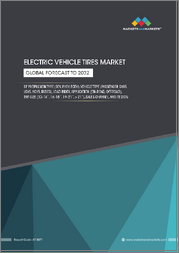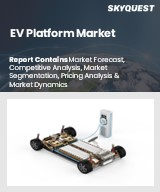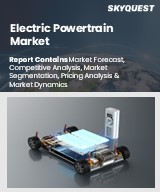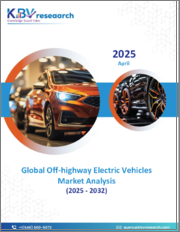
|
시장보고서
상품코드
1341008
세계의 배터리 전기자동차(BEV)시장 : 모드별, 지역별 분석, 규모, 동향, COVID-19 영향, 예측(-2028년)Global Battery Electric Vehicle (BEV) Market: Analysis By Mode (Cars, Buses, Trucks, and Vans), By Region Size and Trends with Impact of COVID-19 and Forecast up to 2028 |
||||||
세계의 배터리 전기자동차(BEV)시장 규모는 2022년 2,097억 1,000만 달러에서 2028년까지 5,256억 5,000만 달러에 달할 것으로 예상되며, 2023-2028년의 예측 기간 동안 CAGR로 18.6% 성장이 예측됩니다.
최근 몇 년동안 배터리 전기자동차(BEV)의 인기 증가는 다양한 요인으로 인해 발생할 수 있습니다. 그 중에서도 환경 의식의 높아짐이 큰 역할을 하고 있습니다. 지구 온난화와 대기 오염에 대한 의식이 계속 증가하고 있는 가운데, 많은 소비자들은 보다 깨끗한 대안으로 눈을 돌리고 BEV는 지속 가능한 운송 옵션으로 부상하고 있습니다. 또한 세계 각국의 정부가 BEV 도입을 장려하기 위해 세액 공제 및 보조금 등 정책 인센티브를 실시하고 있으며, BEV는 보다 저렴한 선택이 되고 있습니다. 마지막으로 배터리 기술의 발전으로 BEV의 성능이 크게 향상되었습니다. 배터리용량의 향상은 한 번의 충전으로 항속 거리의 연장을 의미하며 BEV 보급의 큰 장애 중 하나를 극복하고 있습니다. 마찬가지로 충전 시간의 단축은 사용자에게 BEV의 편의성을 높이고 BEV의 보급을 더욱 촉진하고 있습니다.
세계의 배터리 전기자동차(BEV)시장에 대해 조사 분석했으며, 시장 역학/COVID-19 영향/경쟁 구도 등 정보를 제공합니다.
목차
제1장 주요 요약
제2장 소개
- 배터리 전기자동차(BEV) : 개요
- 배터리 전기자동차(BEV)의 정의
- BEV 도입의 장점
- 배터리 전기자동차(BEV)의 세분화 : 개요
제3장 시장 분석
- 세계의 BEV 시장 : 분석
- 세계의 BEV 시장 : 개요
- 세계의 BEV 시장 매출
- 세계의 BEV 시장 판매 대수 : 분석
- 세계의 BEV 시장 판매 대수 : 개요
- 세계의 BEV 시장 판매 대수
- 세계의 BEV 시장 판매 대수 : 모드별(승용차, 버스, 밴, 트럭)
- 세계의 BEV 시장 판매 대수 : 지역별(아시아 태평양, 유럽, 북미, 기타 지역)
- 세계의 BEV 시장 판매 대수 : 모드 분석
- 세계의 BEV 시장 판매 대수 : 모드별, 개요
- 세계의 승용차 BEV 시장 판매 대수
- 세계의 버스 BEV 시장 판매 대수
- 세계의 밴 BEV 시장 판매 대수
- 세계의 트럭 BEV 시장 판매 대수
제4장 지역 시장 분석
- 아시아 태평양의 BEV 시장 판매량 : 분석
- 아시아 태평양의 BEV 시장 판매 대수 : 개요
- 아시아 태평양의 BEV 시장 판매 대수
- 아시아 태평양의 승용차, 버스, 밴, 트럭 BEV 시장 판매 대수
- 아시아 태평양의 BEV 시장 판매량 : 지역별(중국, 한국, 일본, 인도, 기타 아시아 태평양)
- 중국의 BEV 시장 판매 대수
- 한국의 BEV 시장 판매 대수
- 일본의 BEV 시장 판매 대수
- 인도의 BEV 시장 판매 대수
- 기타 아시아 태평양의 BEV 시장 판매량
- 유럽의 BEV 시장 판매량 : 분석
- 유럽의 BEV 시장 판매 대수 : 개요
- 유럽의 BEV 시장 판매 대수
- 유럽의 승용차, 밴, 버스, 트럭의 BEV 시장 판매 대수
- 유럽의 BEV 시장 판매 대수 : 지역별(독일, 영국, 프랑스, 노르웨이, 기타 유럽)
- 독일의 BEV 시장 판매 대수
- 영국의 BEV 시장 판매 대수
- 프랑스의 BEV 시장 판매 대수
- 노르웨이의 BEV 시장 판매 대수
- 기타 유럽의 BEV 시장 판매 대수
- 북미의 BEV 시장 판매량 : 분석
- 북미의 BEV 시장 판매 대수 : 개요
- 북미의 BEV 시장 판매 대수
- 북미의 BEV 시장 판매 대수 : 지역별(미국, 캐나다, 멕시코)
- 미국의 BEV 시장 판매 대수
- 캐나다의 BEV 시장 판매 대수
- 멕시코의 BEV 시장 판매 대수
- 기타 지역의 BEV 시장 판매량 : 분석
- 기타 지역의 BEV 시장 판매 대수 : 개요
- 기타 지역의 BEV 시장 판매 대수
제5장 COVID-19 영향
- 세계의 BEV 시장에 대한 COVID-19 영향
- 세계의 BEV 시장에 대한 COVID-19 이후 영향
제6장 시장 역학
- 성장 촉진 요인
- 배터리 비용 저하
- 연료 가격의 확대
- 정부 정책과 인센티브
- 다양한 BEV 모델과 법인 차량에 도입
- 환경 문제에 대한 우려 증가
- 라이프사이클 분석(LCA)개선
- 과제
- 원재료의 제약
- 배터리의 유해한 재활용과 폐기
- 시장 동향
- BEV의 보급
- AI와 머신러닝(ML)의 진보
- 자율주행 기술
- 차세대 배터리 기술의 출현
- 인프라 개발
- 무선 충전 기술의 도입
- 소형 자동차의 보급
- 신재생에너지원과 V2G(Vehicle-to-Grid)의 통합
- 공유 모빌리티와 라이드 헤일링 서비스
제7장 경쟁 구도
- 세계의 배터리 전기자동차(BEV)시장 : 경쟁 구도
- 세계의 배터리 전기자동차(BEV)기업 : 시장 점유율별
- 중국의 배터리 전기자동차(BEV)기업 : 시장 점유율별
- 유럽의 배터리 전기자동차(BEV)기업 : 시장 점유율별
- 북미의 배터리 전기자동차(BEV)기업 : 시장 점유율별
- 세계의 배터리 전기자동차(BEV)시장 기업 : 제공 제품
- 중국의 배터리 전기자동차(BEV)시장 기업 : 제공 제품
- 유럽의 배터리 전기자동차(BEV)시장 기업 : 제공 제품
- 북미의 배터리 전기자동차(BEV)시장 기업 : 제공 제품
제8장 기업 개요
- General Motors Company
- Mercedes-Benz Group AG
- Volvo Group
- Renault Group
- Tesla Inc.
- Nissan Motor Co., Ltd.
- Bayerische Motoren Werke AG(BMW Group)
- Volkswagen Group
- Stellantis NV
- Ford Motor Company
- Hyundai Motor Company
- NIO Inc.
- BYD Company Limited
- Rivian Automotive, Inc.
- Zhejiang Geely Holding Group Co., Ltd.(Volvo Cars)
The global Battery Electric Vehicle (BEV) market in 2022 stood at US$209.71 billion and is likely to reach US$ 525.65 billion by 2028. A Battery Electric Vehicle (BEV) is a type of electric vehicle that uses chemical energy stored in rechargeable battery packs for propulsion. Unlike traditional vehicles powered by internal combustion engines, BEVs produce no tailpipe emissions, offer a quieter and smoother driving experience, and have lower operating and maintenance costs due to fewer moving parts.
The rising popularity of Battery Electric Vehicles (BEVs) over recent years can be attributed to various factors. Among these, increased environmental consciousness has played a significant role. As the awareness about global warming and air pollution continues to grow, many consumers are turning to cleaner alternatives, with BEVs emerging as a sustainable transportation option. Additionally, governments worldwide have implemented policy incentives like tax credits and subsidies to encourage the adoption of BEVs, making them a more affordable choice. Finally, advancements in battery technology have significantly improved the performance of BEVs. Enhanced battery capacity means a longer range per charge, thereby overcoming one of the major obstacles to BEV adoption. Similarly, reductions in charging time have made BEVs more convenient for users, further driving their adoption. The global Battery Electric Vehicle (BEV) market is projected to grow at a CAGR of 18.6% during the forecast period of 2023-2028.
Market Segmentation Analysis:
By Mode: The report has segmented the global Battery Electric Vehicle (BEV) market into four segments namely, cars, buses, vans, and trucks. In 2022, the Car segment dominated the market, driven by rising popularity among consumers due to increased awareness about the environmental benefits, enhanced battery life, and improved charging infrastructure. Governmental incentives and subsidies have made BEVs more affordable, leading to their increased adoption. Technological advancements have led to significant improvements in battery efficiency and lifespan, thus offering longer driving ranges and reduced charging times. An array of available models from compact to luxury, offered by major automakers, provides consumers with greater choice and flexibility.
Furthermore, the ongoing expansion of the charging infrastructure has made BEVs more practical for everyday use, contributing to their increasing market dominance. Further, the Bus segment, during the forecasted period of 2023-2028, is expected to be the fastest-growing segment, owing to increased governmental support, stricter emission regulations, technological advancements making BEVs more cost-effective, and public transportation agencies' desire to reduce carbon footprints.
By Region: According to this report, the global Battery Electric Vehicle (BEV) market by sales volume can be divided into four major regions: Asia Pacific (China, South Korea, Japan, India, and Rest of Asia Pacific), Europe (Germany, UK, France, Norway, and Rest of Europe), North America (The US, Canada, and Mexico), and Rest of the World. In 2022, Asia Pacific dominates the global Battery Electric Vehicle (BEV) market due to its proactive governmental policies, heightened environmental consciousness, rapidly urbanizing cities, and burgeoning e-commerce sector. Particularly, China's extensive support for BEVs, significant investments in charging infrastructure, and the aggressive stance of local automakers have cemented its leading position. The drop in battery costs, rendering BEVs more affordable, further fuels consumer demand across the region. Upcoming years also anticipate rapid growth for India's EV market, propelled by robust government policies promoting e-mobility and an emerging consumer market valuing sustainability and cost-effectiveness.
The North America Battery Electric Vehicle (BEV) market is expected to grow at the fastest CAGR from 2023 to 2028, driven by rising environmental consciousness, favorable government policies, declining EV costs due to battery technology advancements, and the presence of industry pioneers like Tesla. Additionally, increased investment in charging infrastructure, the rise of shared mobility services, and the need for efficient transportation solutions in a rapidly urbanizing and expanding e-commerce environment further fuel this growth. Particularly, the US, with its vast consumer market, supportive government initiatives, developed charging network, and high consumer awareness, leads this growth trajectory.
Global Battery Electric Vehicle (BEV) Market Dynamics:
Growth Drivers: The global Battery Electric Vehicle (BEV) market's growth is significantly influenced by governmental policies and incentives. Recognizing environmental and energy benefits, countries have provided subsidies, tax incentives, and infrastructure development, making BEVs financially attractive. These measures, like carpool lane access and toll waivers, coupled with regulatory strategies like stricter emission standards and forthcoming bans on internal combustion engines, have reshaped the automotive landscape. Key regions like Europe, the US, China, and Japan have proposed or implemented transformative policies. For example, The US aims for 50% BEV or PHEV sales by 2030, with enhanced subsidy structures. Therefore, governmental strategies are rapidly advancing a sustainable, BEV-driven future. Further, the market is expected to grow owing to falling battery costs, rising fuel prices, diverse BEV models and adoption by corporate fleets, rising environmental concerns, improvements in Life Cycle Analysis (LCA), etc. in recent years.
Challenges: Battery Electric Vehicles (BEVs) have demonstrated great potential as sustainable transport options. However, an impending challenge is managing end-of-life batteries. Current methods for recycling and disposal of these batteries, primarily lithium-ion, are insufficient. Improper disposal may lead to environmental pollution and loss of valuable materials. Concurrently, recycling methods are typically energy-consuming and expensive. As the BEV market expands, the volume of spent batteries is projected to increase substantially, magnifying these issues. Consequently, the challenge of battery disposal and recycling poses a significant obstacle to continued BEV market growth. Additionally, other factors like raw material constraints, etc. are other challenges to the market.
Market Trends: The global Battery Electric Vehicles (BEVs) market is anticipated to experience significant expansion in the coming years, driven by increasing public awareness and shifting perceptions towards BEVs. As understanding of environmental sustainability deepens, and the negative implications of traditional fuel vehicles become widely recognized, a transition towards more environmentally-friendly modes of transportation such as BEVs is expected to accelerate. Public perceptions, shaped by factors like environmental impacts, economic concerns, and the practicality of BEVs, are key to driving their adoption. Therefore, educational initiatives highlighting the benefits of BEVs, along with supportive government policies and media representations, can greatly amplify market growth. More trends in the market are believed to grow the BEV market during the forecasted period, which may include advancements in Artificial Intelligence (AI) and Machine Learning (ML), autonomous driving technology, the emergence of next generation of battery technology, adoption of wireless charging technology, infrastructure development, integration of renewable energy sources and Vehicle-to-Grid (V2G), shared mobility and ride-hailing services, etc.
Impact Analysis of COVID-19 and Way Forward:
The COVID-19 pandemic has triggered a global shift towards public health and environmental sustainability, driving demand for eco-friendly transportation, such as Battery Electric Vehicles (BEVs). Government incentives, alongside the decreased need for long-distance commutes due to remote work, have made BEVs an attractive choice for consumers. These factors collectively have been instrumental in the expansion of the global BEV market. The post-COVID impact on the BEV market is set to further galvanize its growth trajectory. Heightened environmental awareness, spurred by the pandemic, will continue to drive consumer demand for cleaner and sustainable alternatives. Moreover, governments across the globe are strategizing green recovery plans, prioritizing investments in low-carbon technologies, including BEVs. Supply chains, impacted by the pandemic, are expected to become more localized, providing opportunities for domestic BEV manufacturers. A concurrent push for renewable energy, coupled with a shift in consumer preferences towards sustainability, further underscores the potential for accelerated growth of the BEV market in the post-COVID era.
Competitive Landscape and Recent Developments:
The global BEV market is competitive and varied landscape with key players like Tesla, BYD, BMW Group, and Daimler AG. A mix of consolidation in regions like China, and fragmentation in others like Europe, exhibits the dynamic nature of the market. The sector is further energized by strategic alliances such as the joint venture by seven automakers - BMW Group, General Motors, Honda, Hyundai, Kia, Mercedes-Benz Group, and Stellantis NV - aiming to install at least 30,000 high-powered charging points across North America, thus bolstering the BEV infrastructure and market growth.
Further, key players in the Battery Electric Vehicle (BEV) market are:
General Motors Company
Mercedes-Benz Group AG
Volvo Group
Renault Group
Tesla Inc.
Nissan Motor Co., Ltd.
Bayerische Motoren Werke AG (BMW Group)
Volkswagen Group
Stellantis N.V.
Ford Motor Company
Hyundai Motor Company
NIO Inc.
BYD Company Limited
Rivian Automotive, Inc.
Zhejiang Geely Holding Group Co., Ltd. (Volvo Cars)
In 2022, the top 5 companies in the sector evidently play a commanding role, having captured approximately 47% of the global market. Major manufacturers such as Stellantis, Volkswagen, and Toyota continually innovate and launch new products to meet the burgeoning demand for BEVs. For instance, Stellantis plans to offer a significant number of new BEV products in the US and Europe, Volkswagen leads the market with its in-demand electric SUV offering, and Toyota is set to roll out next-generation BEVs globally. As evidenced by OEM EV ambitions, companies across the board are setting significant targets to increase their BEV offerings, revealing an industry-wide shift towards electrification. This transition is fueled by a growing variety of BEV models and increasing adoption by corporate fleets, which not only drives demand but also raises public awareness of BEVs. Popular models like Tesla's Model Y and Model 3, Aion's Aion S and Aion Y, and BYD's Yuan and Dolphin exemplify the expanding and diverse range of BEVs available to consumers, thus boosting market growth.
Table of Contents
- 2.1 Battery Electric Vehicle (BEV): An Overview
- 2.1.1 Definition of Battery Electric Vehicle (BEV)
- 2.1.2 Advantages of Adoption of BEVs
- 2.2 Battery Electric Vehicle (BEV) Segmentation: An Overview
- 2.2.1 Battery Electric Vehicle (BEV) Segmentation
- 3.1 Global BEV Market: An Analysis
- 3.1.1 Global BEV Market: An Overview
- 3.1.2 Global BEV Market by Value
- 3.2 Global BEV Market Sales Volume: An Analysis
- 3.2.1 Global BEV Market Sales Volume: An Overview
- 3.2.2 Global BEV Market Sales by Volume
- 3.2.3 Global BEV Market Sales Volume by Mode (Cars, Buses, Vans, and Trucks)
- 3.2.4 Global BEV Market Sales Volume by Region (Asia Pacific, Europe, North America, and Rest of the World)
- 3.3 Global BEV Market Sales Volume: Mode Analysis
- 3.3.1 Global BEV Market Sales Volume by Mode: An Overview
- 3.3.2 Global Cars BEV Market Sales by Volume
- 3.3.3 Global Buses BEV Market Sales by Volume
- 3.3.4 Global Vans BEV Market Sales by Volume
- 3.3.5 Global Trucks BEV Market Sales by Volume
- 4.1 Asia Pacific BEV Market Sales Volume: An Analysis
- 4.1.1 Asia Pacific BEV Market Sales Volume: An Overview
- 4.1.2 Asia Pacific BEV Market Sales by Volume
- 4.1.3 Asia Pacific Cars, Buses, Vans, and Trucks BEV Market Sales by Volume
- 4.1.4 Asia Pacific BEV Market Sales Volume by Region (China, South Korea, Japan, India, and Rest of Asia Pacific)
- 4.1.5 China BEV Market Sales by Volume
- 4.1.6 South Korea BEV Market Sales by Volume
- 4.1.7 Japan BEV Market Sales by Volume
- 4.1.8 India BEV Market Sales by Volume
- 4.1.9 Rest of Asia Pacific BEV Market Sales by Volume
- 4.2 Europe BEV Market Sales Volume: An Analysis
- 4.2.1 Europe BEV Market Sales Volume: An Overview
- 4.2.2 Europe BEV Market Sales by Volume
- 4.2.3 Europe Cars, Vans, Buses, and Trucks BEV Market Sales by Volume
- 4.2.4 Europe BEV Market Sales Volume by Region (Germany, UK, France, Norway, and Rest of Europe)
- 4.2.5 Germany BEV Market Sales by Volume
- 4.2.6 UK BEV Market Sales by Volume
- 4.2.7 France BEV Market Sales by Volume
- 4.2.8 Norway BEV Market Sales by Volume
- 4.2.9 Rest of Europe BEV Market Sales by Volume
- 4.3 North America BEV Market Sales Volume: An Analysis
- 4.3.1 North America BEV Market Sales Volume: An Overview
- 4.3.2 North America BEV Market Sales by Volume
- 4.3.3 North America BEV Market Sales Volume by Region (The US, Canada, and Mexico)
- 4.3.4 The US BEV Market Sales by Volume
- 4.3.5 Canada BEV Market Sales by Volume
- 4.3.6 Mexico BEV Market Sales by Volume
- 4.4 Rest of the World BEV Market Sales Volume: An Analysis
- 4.4.1 Rest of the World BEV Market Sales Volume: An Overview
- 4.4.2 Rest of the World BEV Market Sales by Volume
- 5.1 Impact of COVID-19 on Global BEV Market
- 5.2 Post-COVID-19 Impact on Global BEV Market
- 6.1 Growth Drivers
- 6.1.1 Falling Battery Costs
- 6.1.2 Rising Fuel Prices
- 6.1.3 Government Policies and Incentives
- 6.1.4 Diverse BEV Models and Adoption by Corporate Fleets
- 6.1.5 Rising Environmental Concerns
- 6.1.6 Improvements in Life Cycle Analysis (LCA)
- 6.2 Challenges
- 6.2.1 Raw Material Constraints
- 6.2.2 Harmful Recycling and Disposal of Batteries
- 6.3 Market Trends
- 6.3.1 Increasing BEV Penetration
- 6.3.2 Advancements in Artificial Intelligence (AI) and Machine Learning (ML)
- 6.3.3 Autonomous Driving Technology
- 6.3.4 Emergence of Next Generation of Battery Technology
- 6.3.5 Infrastructure Development
- 6.3.6 Adoption of Wireless Charging Technology
- 6.3.7 Popularization of Mini-cars
- 6.3.8 Integration of Renewable Energy Sources and Vehicle-to-Grid (V2G)
- 6.3.9 Shared Mobility and Ride-Hailing Services
- 7.1 Global Battery Electric Vehicle (BEV) Market: Competitive Landscape
- 7.2 Global Battery Electric Vehicle (BEV) Players by Market Share
- 7.3 Mainland China Battery Electric Vehicle (BEV) Players by Market Share
- 7.4 Europe Battery Electric Vehicle (BEV) Players by Market Share
- 7.5 North America Battery Electric Vehicle (BEV) Players by Market Share
- 7.6 Global Battery Electric Vehicle (BEV) Market Players: Product Offerings
- 7.7 Mainland China Battery Electric Vehicle (BEV) Market Players: Product Offerings
- 7.8 Europe Battery Electric Vehicle (BEV) Market Players: Product Offerings
- 7.9 North America Battery Electric Vehicle (BEV) Market Players: Product Offerings
- 8.1 General Motors Company
- 8.1.1 Business Overview
- 8.1.2 Operating Segments
- 8.2.3 Business Strategy
- 8.2 Mercedes-Benz Group AG
- 8.2.1 Business Overview
- 8.2.2 Operating Segments
- 8.2.3 Business Strategy
- 8.3 Volvo Group
- 8.3.1 Business Overview
- 8.3.2 Operating Segments
- 8.3.3 Business Strategy
- 8.4 Renault Group
- 8.4.1 Business Overview
- 8.4.2 Operating Segments
- 8.4.3 Business Strategy
- 8.5 Tesla Inc.
- 8.5.1 Business Overview
- 8.5.2 Operating Segment
- 8.5.3 Business Strategy
- 8.6 Nissan Motor Co., Ltd.
- 8.6.1 Business Overview
- 8.6.2 Operating Segment
- 8.6.3 Business Strategy
- 8.7 Bayerische Motoren Werke AG (BMW Group)
- 8.7.1 Business Overview
- 8.7.2 Operating Segment
- 8.7.3 Business Strategy
- 8.8 Volkswagen Group
- 8.8.1 Business Overview
- 8.8.2 Operating Segment
- 8.8.3 Business Strategy
- 8.9 Stellantis N.V.
- 8.9.1 Business Overview
- 8.9.2 Operating Segment
- 8.9.3 Business Strategy
- 8.10 Ford Motor Company
- 8.10.1 Business Overview
- 8.10.2 Operating Segments
- 8.10.3 Business Strategy
- 8.11 Hyundai Motor Company
- 8.11.1 Business Overview
- 8.11.2 Operating Segments
- 8.11.3 Business Strategy
- 8.12 NIO Inc.
- 8.12.1 Business Overview
- 8.12.2 Business Strategy
- 8.13 BYD Company Limited
- 8.13.1 Business Overview
- 8.13.2 Business Strategy
- 8.14 Rivian Automotive, Inc.
- 8.14.1 Business Overview
- 8.15 Zhejiang Geely Holding Group Co., Ltd. (Volvo Cars)
- 8.15.1 Business Overview
- 8.15.2 Business Strategy



















